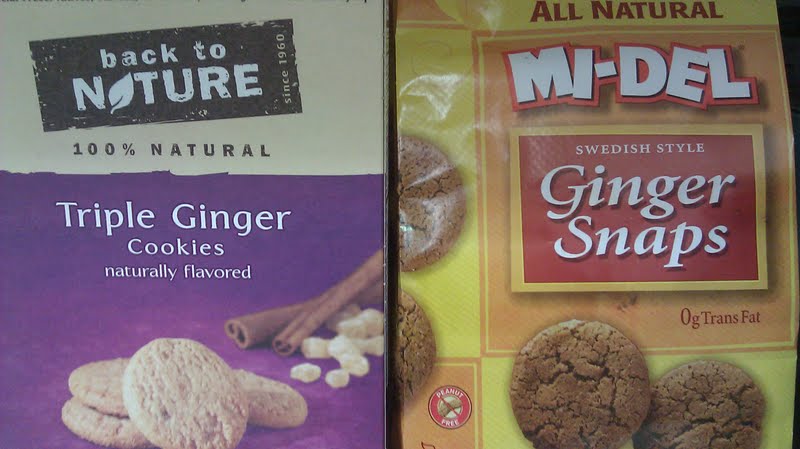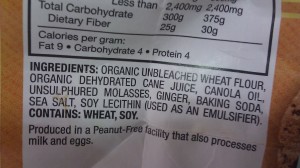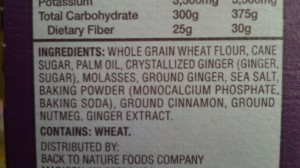Table of Contents[Hide][Show]

Does the snack aisle at your local healthfood store sometimes paralyze you? Do you look at the ingredients labels trying to decide exactly which cookies are the best ones to buy and yet feel overwhelmed by the numerous choices available all beckoning with the labels “all natural” or “organic”?
If so, you are not alone. This happens to me all the time.
Granted, I try my best to avoid the snack aisle at the healthfood store as much as possible and I don’t even go down the snack aisle at the supermarket because there are zero offerings there of any value. As much as is humanly possible, I prefer to make my own snacks for my family as this is always the most nutritious not to mention budget conscious way to go.
But let’s face it. Life happens and sometimes things just don’t go as scheduled.
All sorts of things from flat tires to your child’s badly scraped knee can occur to mess up your plans for baking an afternoon batch of cookies for school lunches the next day.
What to do then?
I thought it might be fun to analyze two different brands of cookies that I might consider buying when I am in search of a decent after lunch treat for my kids and far behind in my cookie baking duties.
Ginger snaps are one of my favorite store cookies as they are typically lower in sugar per serving than most other types of processed cookies. They also taste similar to the grain free ginger snaps I make myself, so buying a boxed version made with wheat flour on occasion is not going to all of a sudden cause my children to prefer the processed cookies over my own.
The picture at the top of this post is of the two brands of ginger snaps available at my local healthfood store.
Let’s analyze the ingredients labels of each and see if one of them is the clear winner over the other.
The Front of the Cookie Packages
From the front of the packages, you can’t really discern much if any difference. They both say “all natural” or “naturally flavored”.
The Mi-del brand says “Swedish Style” which I admit would draw me in as I like anything that suggests that the cookies are based on some traditional recipe. Of course, this may or may not be true. It’s all just marketing on the front of the package after all!
From a visual standpoint, the colors of the Back to Nature brand are far more appealing than the Mi-Del brand which are a bit harsh on the eye. Then again, purple is my favorite color so maybe that’s just my personal preference.
Ingredients Label Comparison
With the front of the packages not really telling us much, it is necessary to examine the ingredients labels to get the full story.

The first ingredient label to the right is of the Mi-Del Ginger Snaps.
I like that the wheat used is organic. That is a definite plus. In addition, the sweetener is organic dehydrated cane juice which is acceptable.
I don’t like that canola oil is used for the shortening as this is very potentially GM canola as it is not organic. In addition, canola oil is a polyunsaturated vegetable oil which almost certainly means that it is rancid.
Canola contains high amounts of omega 3 fats which are very delicate and can never be heated. You most certainly cannot bake cookies with it!. Use of canola in a boxed snackfood virtually ensures a rancid, health robbing product even if the ingredients are all organic.
Another item I don’t like is the use of soy lecithin. It is not organic soy lecithin, so the odds are good that it is GM soy given that over 90% of the soy in the the United States is genetically modified at present.
The second ingredient label to the right is of the Back to Nature Triple Ginger Cookies.

You’ll notice right away that the wheat flour used is not organic. The sweetener is also not as good quality because it is listed simply as cane sugar. It is not organic and it is not clear whether it is from dehydrated cane juice. It could easily be plain white sugar and probably is.
Not good.
So far, the Mi-Del Ginger Snaps are way in the lead.
However, the next ingredient changes the game entirely as palm oil is listed as the shortening.
This is very good as palm oil is a much healthier choice that the rancid canola oil used in the Mi-Del Ginger Snaps. Palm oil is acceptable for use in cookies and crackers. While coconut oil or butter would be best, palm oil can most definitely be considered a healthy fat.
Continuing down the ingredients label, all the other ingredients are excellent as well with no ominous “soy lecithin” listed.
Which Brand Did I Choose?
After analyzing the ingredients labels for these two boxes of ginger cookies, which brand did I ultimately choose?
If you guessed the Back to Nature Triple Ginger Cookies, you are correct!
The fact that the Mi-Del cookies are made with organic wheat flour and organic evaporated cane juice is insignificant compared with the fact that the Back To nature cookies use the much higher quality palm oil and no soy lecithin.
If you ever find yourself torn between two different brands of snack foods, always choose the one with the healthy fat like palm oil. The fat that is used is much more important than whether the flour or sugar used is organic.
In addition, go for the brand that clearly has no GMOs in it and that would be the Back to Nature brand as well.
Do all Back to Nature cookies get the thumbs up? Not necessarily.
I haven’t checked the labels on all the different cookies offered by this company, so don’t go and buy them without checking closely for yourself.
For that occasional need for a decent box of cookies from the store, though, the Triple Ginger Cookies pass with flying colors.
Sarah, The Healthy Home Economist








“In addition, go for the brand that clearly has no GMOs in it and that would be the Back to Nature brand as well.” I thought GMO Wheat was already out, or is that up next?
I was wondering this as well. Also wondering about it not stating that it is unbleached flour. Is this not a big concern?
THERE IS NO GMO WHEAT. Wheat is only hybridized which is completely different. Nothing wrong with hybrids .. been done for thousands of years. Almost all agricultural plants are hybridized to some extent.
thanks for the practical side by side analysis. I find it so helpful as I continue my new journey of moving away from processed foods. it’s like learning a new language & these types of ‘how to’ articles really take me from theory to reality. thanks!!!!
Great Advice!! I must admit I sometimes treat myself to BtoN “oreos. I’m going to once over that label. Do you know if “palm oil” always indicates palm oil that is not fractionated? I haven’t been able to find a clear answer on this.
After months of abstinence, I recently have been buying crackers again – precisely bcs they use palm oil. Wonder if the word is getting out to the food manufacturers – that transfats, high omega 6, rancid, oxidizing oils are not good for health. I wish restaurants would start tuning in.
Yes, even organic restaurants use that canola/olive oil blend garbage. We have several organic restaurants in my town and I never go there for that reason. I don’t care if all their food is locally sourced (that of course is wonderful). But if the fats that they cook it in are bad, what’s the point?
No point at all. It is a shame that so much good food is ruined by canola oil. I will not touch it, either.
I like BTN products also. I have only tried one Mi-Del product – their graham crackers. *gag*
Oh definitely. My kids wouldn’t eat them. Also, almost every single one was broken.
Anytime I read canola or soy in the ingredients, I put the item back on the shelf. I read ingredients on everything I buy now as one day I brought home a can of albacore tuna in water and when I went to open it I glanced at the ingreadients and saw the water was ‘soy broth.’ I couldn’t believe it! Soy is in everthing and it isn’t mentioned on the front label. I don’t remember the brand of tuna but there are plenty out there without soy. Just be sure to read labels on everything. One month the label might say palm oil and the next month it may change to canola. I call companies and thank them for not using canola or soy whenever I can.
Canola I never make an exception for. If a product has canola or soy oil in it, it is 100% certain I will not buy it regardless of the other ingredients.
Me either Sarah! And just today at our local healthfood store i saw canola oil in their homemade salad dressings that everyone buys thinking its much better because they make it there. I told my sister not to buy their dressings but make it herself. I use to cook with canola oil because I thought it was better before I knew “better” LOL
This is great advice, once again. Unfermented soy and canola oil should be avoided at all costs. GMOs should also be avoided. Unfortunately, some companies, like Whole Foods, add canola or soy to almost all their products.
I had no idea that canola oil was not a good substitute for vegetable oil! i was always told it was! :/
what a great article! Ty 🙂
Good practical advice Sarah. Thanks!
Thanks Rick. I hear your group is going great guns in Safety Harbor. Excellent 🙂